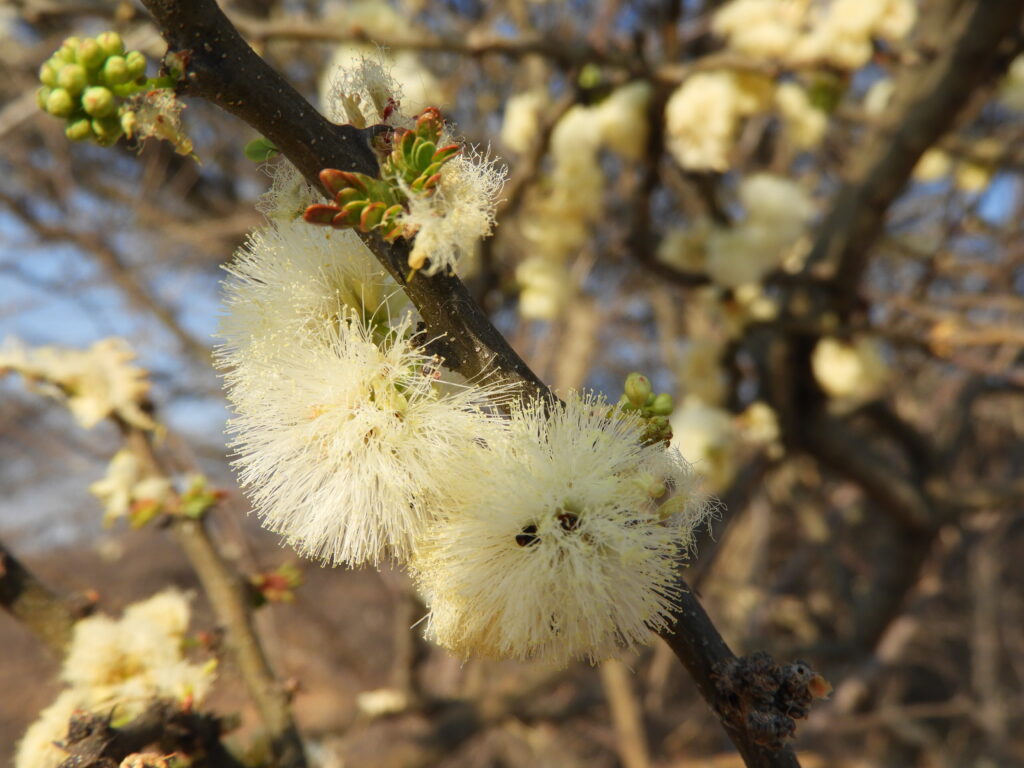In this issue we look at what the so-called ancestor trees are all about and why the blackthorn acacia goes so well with the month September. Herewith the second part of the newsletter series on the flora of the Waterberg.
Tasty bush?
The vast plains around the Waterberg are dominated by senegalia mellifera, a widespread thorn tree / bush in Africa. Common names include Blackthorn, Schwarzdorn (German) and Swarthaak (Afrikaans). It is a reference to the wood, which turns pitch black when oiled.
In some areas of Namibia, the blackthorn is used as fencing for kraals (enclosures) or building material for traditional huts. In drought years, the young twigs are even usable as fodder for livestock. Thereby, the bush is harvested, milled and then mixed with suitable supplements (such as molasses to improve palatability). This type of feeding can replace up to 85 % of a cattle’s required fibre intake during drought periods. However, this should not be a long-term substitute for the animals.
In Namibia, the blackthorn is also better known under the slang name Hakies (-bos). The name refers to the plant’s hook-shaped thorns. The hakies usually begin to flower as early as August / September. The blossoms are the first signs of spring – that is, at least on the southern hemisphere ;).
It’s heavy.
The Herero believe that the combretum imberbe is the ancestral tree from which the first people, cattle and antelopes emerged. Hence the names Omumborongbonga (Herero) and Ahnenbaum (German) – refering to this believe. Though, “subordinate” species such as goats, baboons or even the Damara, were believed to have emerged from stones. Nowadays, only the name reminds of this believe, which has been replaced by the Christian faith.
The common names in English and Afrikaans refer to the heaviness of the wood (at 1200 kg/m3, the tree has the heaviest wood in the world) and the hardness of the charcoal (Hardekool). The wood is also termite-resistant. Thanks to these properties, the tree is often used for the making of tools and equipment. For example, the Owambo use leadwood-beetles to pound mahangu (a kind of millet). Because of its excessive use, the tree is nowadays protected in Namibia and may not be felled without permission.
The tree occurs from central Namibia northwards. It is usually a four to ten meter tall tree with a distinctive gnarled trunk. Easily recognizable by its light grey bark, which splits into narrow rectangular pieces.
The Latin word imberbe (beardless) describes the hairless leaves. The grey-green oval leaves grow in opposite directions, almost at right angles to each other. Elephants, giraffes, kudus and other antelopes feed on the leaves, black rhinos on the young twigs. Feel free to check out our social media. Here we will publish some photos of the plants and leaves.
In the December issue we will have a look how acacias keep giraffes at bay and why Africa technically has no longer any acacias. We also present the tree that many Namibians use as a substitute for a christmas tree.

The blossoms of the blackthorn are the first signs of spring.




